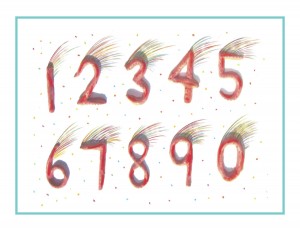Day 8
For one year, 365 days, this blog will address the Common Core Standards from the perspective of creating an alternate, ambient learning environment for math. Ambient is defined as “existing or present on all sides, an all-encompassing atmosphere.” And ambient music is defined as: “Quiet and relaxing with melodies that repeat many times.”
Why ambient? A math teaching style that’s whole and all encompassing, with themes that repeat many times through the years, is most likely to be effective and successful. Today’s blog will focus on the Kindergarten Standard 2, in in Operations and Algebraic Thinking. Note that the Common Core Standards will appear in blue, followed by an ambient translation.
Operations and Algebraic Thinking K.OA
2. Solve addition and subtraction word problems, and add and subtract within 10, e.g., by using objects or drawings to represent the problem.
First a disclaimer on word problems. Perhaps sitting down and reading the problem on paper, then writing the answer is too advanced and abstract for now. It may be better to keep it real, large, and colorful. The “word problem” aspect could simply be a spoken one that’s kept simple and basic and includes lots of guidance throughout, all the way to the answer.
This standard and #’s 3, 4, and 5 are very similar. But rather than addressing them all together, I would like to use their similarity to separately explore different ways of approaching activities with addition and subtraction that are hands-on, movement oriented, creative, playful, and very lively.
Today I’m suggesting that the activity be taken outside: outdoors and outside the box. The exclusion of nature from our everyday lives is endemic, and it seems the children suffer most from this lack of exposure to nature. In fact, it is. now recognized as NDD, nature-deficit disorder. Here are a few excerpts about it from McMillan Buzz Word:
” . . . the premise of nature-deficit disorder goes beyond a simple lack of exposure to the countryside. The suggestion is that this is more like an illness, with symptoms which might include depression, hyperactivity, boredom, and loneliness . . . research suggests that a child’s ‘radius of activity’ . . . has declined by 90% since the 1970’s.”
“The expression nature deficit disorder was coined in 2005 by Richard Louv. The term originates from his bestselling book on the same topic entitled Last Child in the Woods – Saving Our Children from Nature-Deficit Disorder(Algonquin Books, 2005).”
In light of this, it may be highly beneficial to take some of your school activities out of doors. Barring this, due to extreme weather or other obstacles, by all means bring the great outdoors in! Here are some ideas:
Tall, ancient cedars grace our front yard where we live. They prolifically drop bark, seeds, and branches, so there are sticks everywhere! Go out with your child(ren) to the nearest woods, or just your own backyard, and gather a good amount of straight sticks. Learning large seems to be most effective, so look for sticks that are 18″ – 24″ long.
When you’ve gathered at least 20, set them aside in a pile on an open, flat area of grass or ground. If you’re working indoors, a bare floor space works. Borrow some of the verses from Over In the Meadow (Day 3 of this blog) to create some word problems like, “Crow needed more sticks to keep building her nest. She found 4 yesterday and 2 today, how many sticks did she find altogether?”
Or, “The old mother frog had trouble keeping track of her little froggies 7! They loved to jump everywhere in the meadow grass, and sometimes when the grass grew very tall, they were lost from her sight. Let’s pretend these sticks are the froggies and count 7 of them. Now let’s see, today 2 of them are hiding in the tall grass, so how many are left?”
You can use many other natural objects besides sticks for this, and have lots of fun with creating the word problems. Have the child(ren) act them out as well, jumping in the grass, and so on. It’s helpful to take the word problems from a familiar context, like a story you’ve told, a song you’ve sung, etc. Or make them up on the spot, drawing from the natural world all around you.
For the drawing portion of the standard, take one of the sticks and represent the numbers by drawing them on the ground or in the sand. If indoors, use large paper with crayons for counting on paper. You can use the lines mentioned yesterday: l, l l, l l l, l l l l, and l l l l with a diagonal line through it for 5 (two of them for 10). Or the dots that were used for the counting stones (with a different color, larger dot for 10). No numerals yet! They will come soon enough, next year . . .
Knowledge ensues in an environment dedicated to imaginative, creative knowing, where student and teacher alike surrender to the ensuing of that knowledge as a worthy goal. More Kindergarten tomorrow!












